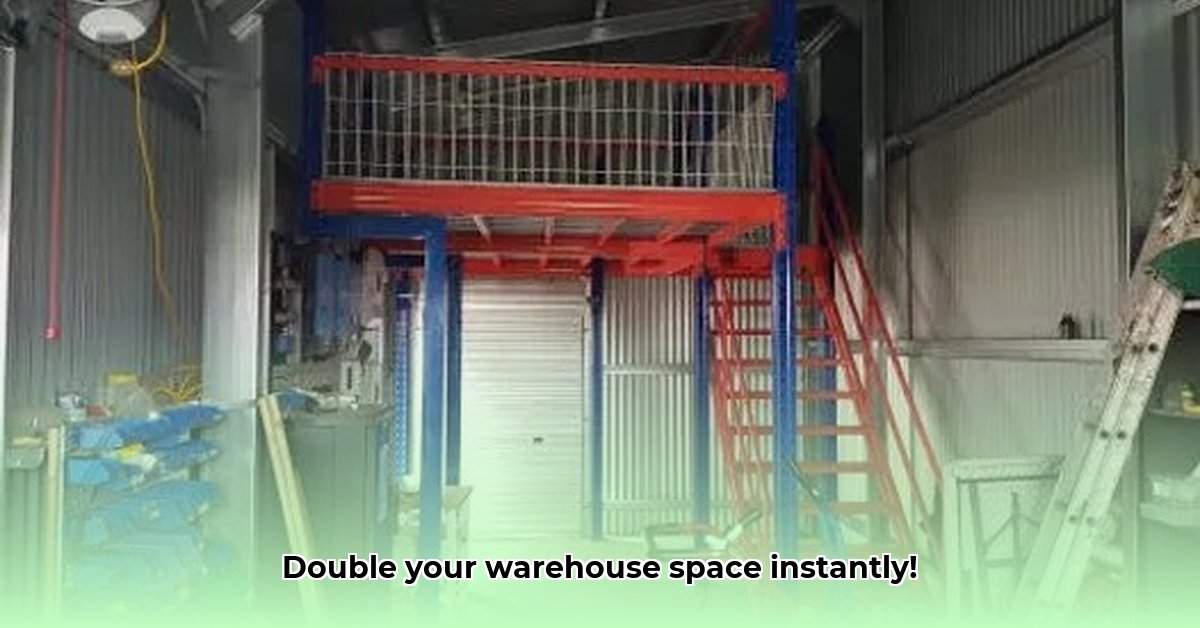Running out of room in your warehouse? Feeling the pinch of limited space and inefficient storage? A custom mezzanine floor kit might be your answer. This guide will walk you through everything you need to know about adding a second level to your warehouse – from planning and design to installation and maintenance. We’ll compare different kits, help you choose the right one for your needs, and show you how to avoid costly mistakes. Think of it as adding a whole new floor to your existing space, quickly and efficiently. This isn’t just about more square footage; it’s about making your entire operation smoother and more profitable in the long run. For more information on warehouse mezzanine solutions, check out this resource.
Custom Mezzanine Floor Kits: Maximizing Warehouse Storage Solutions
Adding extra space to your warehouse can be a game-changer, and custom mezzanine floor kits offer a fast and efficient solution. But before you dive in, let’s explore how to make this project a success. This guide will walk you through the process, from initial planning to long-term maintenance, including addressing the critical aspect of warehouse storage solutions.
Planning Your Custom Mezzanine Floor Kit Installation: Strengthening Space Efficiency
Think of installing a mezzanine like building a deck – you wouldn’t start nailing without a plan! Thorough planning is your secret weapon to a safe and functional mezzanine. First, honestly assess your space needs. How much extra storage do you really require? Don’t overestimate; accurate measurements prevent wasted resources. A detailed needs assessment should also include anticipated growth over the next 3-5 years to ensure the mezzanine can accommodate future requirements.
Next, consider the weight your mezzanine will carry. Will you be storing heavy machinery or lighter goods? The weight capacity directly impacts the design and materials needed. This is where seeking professional consultation from a structural engineer might be valuable – an expert can help determine an accurate load capacity based on your planned use and applicable building codes. They can also advise on optimal column placement to maximize usable space beneath the mezzanine.
Think about the height clearances. Will forklifts or other machinery need to operate beneath the mezzanine? Sufficient headroom prevents costly accidents and ensures smooth operations. A standard clearance height for forklift operation is typically 16-20 feet. Also, consider the height requirements for any equipment that will be placed on the mezzanine. Finally, access is crucial. Plan for safe and convenient access points – stairs, ladders, or even a goods lift – factoring in your employees’ needs, accessibility requirements (ADA compliance), and safety regulations. Consider the placement of access points in relation to workflow and existing traffic patterns.
Before you even order materials, check your local building codes and regulations. Compliance is non-negotiable, and ignoring this step could lead to costly delays, fines, and even legal issues. Engage a qualified architect or engineer to ensure your design meets all applicable codes related to fire safety, seismic activity, and structural integrity. Some experts suggest contacting your local building department early in the planning stages for guidance and to understand the permitting process. This can save significant time and resources later in the project. Be prepared to submit detailed drawings, load calculations, and material specifications as part of the permit application.
Selecting the Right Custom Mezzanine Floor Kit: Finding the Perfect Steel Structure
Choosing the right vendor is just as important as choosing the right design. This is where careful research pays off. Don’t just focus on the initial price; consider the overall value, including material quality, engineering support, installation services, and warranty coverage. Some vendors might offer lower upfront costs but skimp on quality materials, engineering certifications, or comprehensive warranties.
Compare several vendors, examining their features, pricing, and, critically, their track records and certifications. Online reviews and references from past clients can provide invaluable insights. Look for vendors with a proven history of quality workmanship, adherence to safety standards, and excellent customer service. Verify that the vendor is certified by relevant industry organizations and has experience with similar projects. Consider whether they offer comprehensive maintenance plans – these can be invaluable in the long run, saving you money and hassle. Approximately 60% of mezzanine failures are due to poor or non-existent maintenance, highlighting the importance of this aspect. Inquire about the vendor’s quality control processes and inspection procedures.
Remember to carefully review warranties. What’s covered? How long is the warranty valid for? Understanding these details can help you choose a vendor offering long-term reliability and support. Some experts believe that a longer warranty reflects confidence in the product’s quality and durability. Pay close attention to the warranty exclusions and limitations.
Here’s a table to help organize your research:
| Vendor | Price Range | Material Options | Load Capacity (lbs/sq ft) | Warranty (Years) | Reputation | Maintenance Plan? | Engineering Certifications | Installation Services |
|---|---|---|---|---|---|---|---|---|
| Vendor A | $XXX – $YYY | Steel, Aluminum | XXX | 5 | Good | Yes | AISC, AWS | Yes |
| Vendor B | $ZZZ – $AAA | Steel, Wood, Aluminum | ZZZ | 10 | Excellent | Yes | AISC, AWS, IBC | Yes |
| Vendor C | $BBB – $CCC | Steel | BBB | 3 | Fair | No | AWS | No |
(Remember to replace placeholders with actual data from your research. These are just examples)
Mezzanine Installation Options: Weighing DIY vs. Professional Expertise
This decision significantly impacts safety and the project’s overall success. While a DIY approach might seem cheaper initially, the risks of improper installation are considerable. A poorly constructed mezzanine poses serious safety hazards, potentially leading to injuries, structural failure, and legal repercussions. Furthermore, DIY installation can void warranties and create challenges when obtaining necessary permits and inspections.
Unless you have extensive experience in structural engineering and construction, hiring professional installers is strongly recommended. Professional installers possess the expertise, specialized tools, and insurance coverage required for safe and efficient installation, minimizing risks and ensuring compliance with building codes and safety regulations. They can also handle unexpected challenges that may arise during the installation process. However, obtaining multiple competitive quotes from reputable and certified installers is essential. Verify that the installers are licensed, bonded, and insured.
If you decide to proceed with a DIY installation – which is generally not advised – follow the manufacturer’s instructions meticulously and prioritize safety above all else. Obtain all necessary permits and inspections before beginning the work. Rent or purchase appropriate safety equipment, such as harnesses, hard hats, and safety glasses. Always err on the side of caution. There is ongoing research into DIY safety protocols for mezzanine installations, but current data strongly favors professional installation for complex structures due to the inherent risks and potential liabilities.
Typical professional installation services usually include:
- Site Preparation and Leveling: Ensuring a stable and level foundation, including concrete slab analysis and reinforcement if needed.
- Framework Assembly: Precise and accurate assembly of the mezzanine frame, adhering to engineering specifications and tolerances.
- Secure Attachment: Securely fastening the structure to the existing building, using appropriate anchoring methods and hardware.
- Safety Feature Installation: Installing necessary guardrails, handrails, staircases, gates, and other safety components according to OSHA and ADA standards.
- Final Inspections and Certification: Ensuring compliance with building codes and safety standards, providing documentation and certifications as required.
Consider the long-term cost implications of DIY installation, including potential rework, safety incidents, and legal liabilities.
Maintaining Your Custom Mezzanine Floor Kit: Prioritizing Safety and Functionality
Regular maintenance is key to extending the life and ensuring the safety of your mezzanine and the safety and functionality of your team. Annual inspections are a must. Check for loose bolts, signs of wear and tear, corrosion, and any potential safety hazards. Address any issues promptly to prevent minor problems from escalating into major, costly repairs. Consider implementing a preventative maintenance program that includes regular inspections, lubrication of moving parts, and tightening of connections.
Keep the area clean. Removing dust and debris prevents the accumulation of materials that could potentially compromise structural integrity, create fire hazards, and attract pests. Training your employees on safe usage and load limits is also crucial. Avoid overloading the structure at all costs. Always adhere to the manufacturer’s specified load capacity and post load limit signs in prominent locations.
Regular maintenance is more than simply repair; it is an investment in safety, longevity, and operational efficiency. Proactive maintenance will help prevent costly accidents, minimize downtime, and ensure a long lifespan for your mezzanine, maximizing your return on investment. Some experts suggest implementing a formal maintenance schedule integrated with your overall facility maintenance plan and assigning responsibility for maintenance tasks to specific personnel. Keep detailed records of all inspections, maintenance activities, and repairs.
How to Compare Modular Mezzanine System Costs and Installation Timelines
Key Takeaways:
- Mezzanine costs vary widely ($40-$250/sq ft), depending heavily on size, materials, complexity, engineering requirements, and local labor rates.
- Installation typically adds 30-50% to material costs. Freight adds another 10%, but location, accessibility, and fuel costs are major factors in freight costs.
- Custom features (stairs, railings, lifts, specialized flooring) significantly inflate costs. Integrated lighting and fire suppression systems can also add to the expense.
- Larger projects offer per-square-foot cost savings due to economies of scale and efficient use of labor and materials.
- Used mezzanines can be a
- Gray Kitchen Backsplash Ideas: Find Your Perfect Gray Tile - December 11, 2025
- Glass Wall Tiles For Bathroom: A Stylish, Durable Choice - December 10, 2025
- Glass Mosaic Kitchen Backsplash: Add Shimmer and Style - December 9, 2025









